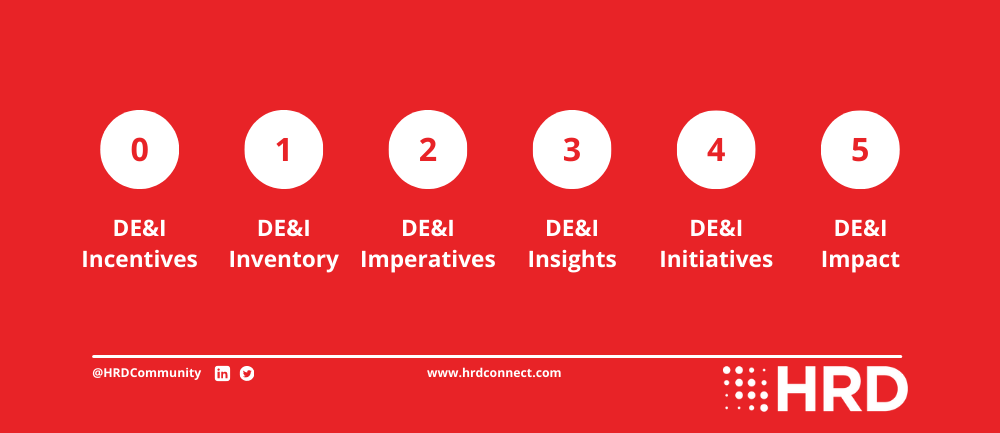Implementing a data-driven approach to achieve measurable DEI progress
- 5 Min Read
Dr Randal Pinkett presents a five-step process to implement a data-driven approach to DEI for HR leaders and their organizations
- Author: Dr. Randal Pinkett
- Date published: Aug 8, 2023
- Categories

Whether it is a personal assessment of preferences and competencies, an organizational survey of culture and climate, or employee interviews and focus groups to gauge their feelings of belonging, data matters to DEI. To be clear, data is not the end-all and be-all of DEI. It is not the entire DEI puzzle, but is a very important piece of the puzzle.
Data is to DEI what an instrument panel is to a plane. Long before there were instrument panels, people were able to fly planes. However, it was significantly harder without the instrument panel. Instrument panels have made the journey more efficient and effective at every step along the way. Similarly, improving DEI can be achieved without data, but it is significantly harder. Data makes the journey more efficient and effective at every step along the way.
Below are five simple steps to implement a data-driven approach to for you and your organization:
Step 0: DEI incentives
The journey begins when people get honest about what motivates their personal and/or organizational DEI journey. This requires self-reflection and introspection to identify intrinsic factors driving your pursuit of DEI, such as personal and organizational values, or extrinsic factors such as bonus incentives or consumer expectations.
People must ask themselves deeper questions such as “Why do I even care?” or “Why should my organization dedicate resources to improving DEI?” You will only need to revisit Step 0 if your incentives change. The next five steps represent a never-ending, continuous cycle as you grow in your DEI journey.
Step 1: DEI inventory
For people undertaking a DEI journey, you will conduct a personal assessment of your preferences, using tools such as the Implicit Association Test (IAT) or the Herrmann Brain Dominance Instrument® (HBDI®), and an assessment of your competences, using tools such as the Intercultural Development Inventory® (IDI®) or the Intrinsic Inclusion Inventory™ (i3™).
For organizations undertaking a DEI journey, you will conduct an organizational assessment comprised of “The 4 P’s”:
(1) people, that is, how employees experience your culture and climate, using assessments such as the DEI Workforce and Workplace Assessment™;
(2) policies and (3) practices, by performing a DEI human resources policies and practices evaluation to identify opportunities and generate recommendations; and
(4) performance, by benchmarking against best practices using tools such as the Global Diversity, Equity & Inclusion Benchmarks (GDEIB).
Step 2: DEI imperatives
OGSM is an acronym that stands for objectives, goals, strategies, and measures. It is a method that can guide people and organizations through a strategic planning process:
- Objectives represent broad and overarching aims.
- Goals are the specific, quantifiable, and qualifiable metrics and key performance indicators (KPIs) for each objective.
- Strategies represent the initiatives, activities, and actions that will be taken to fulfill the objectives and achieve the goals.
- Measures are the specific, quantifiable, and qualifiable measures to gauge progress against each strategy.
During this step, you will establish clearly defined objectives. They may vary dramatically from “appreciating differences personally” to “creating a culture of inclusion and belonging organizationally” and far beyond. As a leader, you and your team will then determine associated and measurable goals for each objective.
Step 3: DEI insights
During this step, you will identify “what works” for other people and organizations based on research, science, and the experience of expert practitioners including people with lived experiences. This will help you avoid reinventing the wheel and optimize your journey.
Examples of “what works” models include Through My Eyes™ Virtual Reality (VR) immersions that foster human understanding and empathy, and The Inclusion Habit®, an incentive-based solution that helps individuals change behaviors and habits to be more inclusive via micro commitments (small daily actions, to which users commit), social accountability and community building.
Examples of “what works” models for organizations include Equitable Analytics™, which uses machine learning to more precisely identify what types of interventions are most likely to work and for whom, and the Rali Change Experience (CX) platform, which drives group-based behavior change that shapes culture and results in organizational impact at large scale.
Step 4: DEI initiatives
You will now determine which DEI strategies are best for you and/or your organization to undertake.
Examples for people include educational classes, books, articles, blogs, and excursions.
Examples for organizations include employee resource groups (ERGs), inclusive hiring, courageous conversations, and employee coaching, learning, and development.
You will also determine the quantifiable DEI measures to gauge progress against each strategy.
Step 5: DEI impact
It’s time to evaluate your results including outputs to gauge progress against your DEI strategies and outcomes to measure impact relative to your objectives.
You will then rinse and repeat from Step 5 back to Step 1 by re-administering your assessment to identify exactly where and with whom you have achieved results as well as areas for improvement.
You will continuously traverse the five-step cycle because DEI is a journey and not a destination.
I’ve led companies and worked with global leaders for more than 30 years. I speak from experience when I say that business leaders need to know two things. First, it is a business imperative in the 21st century. It is no longer a nice to have, it is a need to have. Second, data is one of the essential keys to unlocking the business benefits of DEI, which are myriad.
Perhaps most importantly, just as having mastery of finance, human resources, marketing, sales, technology, and their associated data is necessary for companies to be successful; businesses must also have mastery of DEI and DEI data to succeed. In an increasingly diverse marketplace for talent and customers, people and organizations that embrace an inclusive mindset will outperform their competition.
_______________
Dr. Randal D. Pinkett, author of DATA-DRIVEN DEI, is an entrepreneur, innovator, and DEI expert. He is the co-founder, chairman, and CEO of BCT Partners. An international public speaker, Dr. Pinkett is the author or co-author of Black Faces in High Places, Black Faces in White Places, Campus CEO, and No-Money Down CEO.










